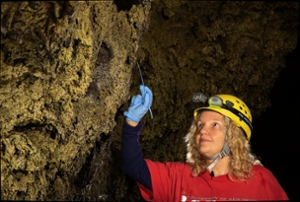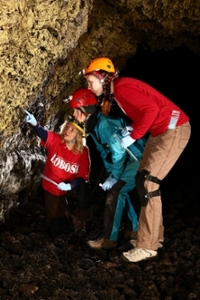Mentor-Mentee relationships: Dr. Diana Northup & Matthew Medina
September 17, 2015 - Yadeeh Sawyer
Two sides of the same coin
We are excited that our very first Two sides of the same coin: Mentor-Mentee relationships blog post highlights the benefits of mentoring from the perspective of Dr. Diana Northup (Biology) and Matthew Medina (now at the University of Michigan).
(Click HERE for more info on our re-occurring blog topics.)

Matthew came to UNM from a smaller community college in Española, New Mexico knowing that he wanted to get research experience because of his long-term goals of going to graduate school in the sciences. He applied, and was accepted into theIMSD program, where the PI of the program,Dr. Maggie Werner-Washburne, suggested that Matthew interview Dr. Diana Northup as a potential mentor, for both the subject matter (microbiology) and mentoring style. Diana has a hands on approach, and her lab known for being a tight knit group of supportive individuals. As she laughed, Diana told me “you are not allowed to be quiet in my lab.”
Being part of a mentoring relationship is beneficial to both the mentor and the mentee. When asked what the most rewarding aspect of such a relation is, Matthew appreciated the level of guidance, both academically, and professionally. “The most rewarding part is having the guidance that I wouldn’t have if I was navigating alone.” From the perspective of the mentor, Diana listed three main rewards: 1) seeing the mentee succeed. Matthew started in a biomedically oriented project that transformed in to a project that looked at microbes that mascarade as minerals, and now has a fully funded fellowship at the University of Michigan in a geomicrobiology lab for graduate school; 2) Seeing the research scientist transformation that occurs over the course of the relationship. There aren’t many undergrads that have the opportunity to go from no research experience to almost publishable data. “Matthew was able to combine biology and geology (geomicrobiology) and ask questions that have implications for life detection on other planets. Seeing that transformation is priceless”; and 3) watching them gain confidence in themselves, especially in relation to their potential as a STEM professional. “They physically carry themselves differently; there is an inner knowledge that they are doing a great job, which is more than just me telling them.”
Matthew described his relationship with Diana as very science based. She taught him a lot about every aspect of research, and a substantial amount of microbial ecology. He did mention, however, that she would give him guidance and advice in non-research based areas when needed, too. The “work” associated with this is founded on communication. “I had to make sure I spoke up to her about any trouble in my research to maintain an effective relationship.”
Diana, on the other hand (or side of the coin), listed coaching as the main driver in their relationship. “I like to start people on a path, but I want them to decide which branch they are going to take.” She had Matthew take a class in scanning electron microscopy (SEM), which he took to the next level and expanded in to what he was passionate about. Diana would meet with him every couple of weeks, encouraged him to try new things, discuss what progress was to date, and where he was going from there. She presented the opportunity for him to apply for an undergraduate research award through the NM Geological Society, which he was awarded! Not only was this outside of his primary field of study, but he also wrote most of the grant on his own. “I get to expose my students to new experiences.” Diana took Matthew to Spider Cave, located in Carlsbad Caverns National Park. He had never been to a cave before, and now he had to crawl through small spaces to collect samples from what looked like geologic formations, but turned out to be living organisms! Diana uses her enthusiasm to open doors to new worlds for students. Diana’s motto in mentoring comes down to an acronym she created: CARE – Caring, Acceptance, Relevance, Enthusiasm. This ties in to her idea of the work involved in a mentoring relationship: Empathy. “You can’t care too much, or you sometimes won’t make the right decision for them…occasionally you have to push, even if it’s not your natural inclination to do so.” Diana is often surprised by the stories she hears about non-acceptance, and noted a shift in the student composition in her freshmen class (~ ½ non-white) and the seniors (primarily white). “I think part of this shift is acceptance (or lack of) by people they work with.”
 Students – do you want to find a mentor of your own? To get started, Matthew says “don’t be afraid to go to somebody’s office hours to talk to them, even if you are not in their class…many times, I had a fear that they didn’t have time to talk to me, but a I was wrong; they seem to enjoy talking to students who are interested in their research…so put yourself out there and talk to them.” Something else to consider when seeking out a mentor is what you need from them. “This is crucial. You need to think about whether you want a directive, a hands-off, or a middle ground mentor” said Diana. Some faculty are more involved than others. Get the word on the street about your potential mentor. If graduate school is your next goal, does this person have a good track record for publications, especially those with students as the first author? Will they push you to go to meetings and present your research? Do they have traits or attitudes that won’t mesh well with your own? “As a mentee, you need to know about yourself – how well do you take criticism, how self-motivated are you, how self-directed?”
Students – do you want to find a mentor of your own? To get started, Matthew says “don’t be afraid to go to somebody’s office hours to talk to them, even if you are not in their class…many times, I had a fear that they didn’t have time to talk to me, but a I was wrong; they seem to enjoy talking to students who are interested in their research…so put yourself out there and talk to them.” Something else to consider when seeking out a mentor is what you need from them. “This is crucial. You need to think about whether you want a directive, a hands-off, or a middle ground mentor” said Diana. Some faculty are more involved than others. Get the word on the street about your potential mentor. If graduate school is your next goal, does this person have a good track record for publications, especially those with students as the first author? Will they push you to go to meetings and present your research? Do they have traits or attitudes that won’t mesh well with your own? “As a mentee, you need to know about yourself – how well do you take criticism, how self-motivated are you, how self-directed?”
In closing, Matthew reiterated that communication is the key in sustaining a mentoring relationship. “If you encounter a problem, the first thing you should do is talk to your mentor because they give you guidance.” Along these lines, Diana encourages mentors to “be sure you have time to commit to working on the relationship...they require a great deal of care and feeding, sometimes literally…it’s like the Kenny Rogers song ‘the Gambler’” which she paraphrased as “know when to hold, when to play, and when to back away. ”
Want to see Diana in action? She is a guest speaker at this year’s UNM Mentoring Institute Conference – New Perspectives in Mentoring on Friday, October 23 at 1 pm in the SUB ballroom C.
Also, here she is as a TEDxABQ event, speaking about Mentoring HERE
(Photos of Matthew by Diana Northup; Photos of Diana by Kenneth Ingham)
